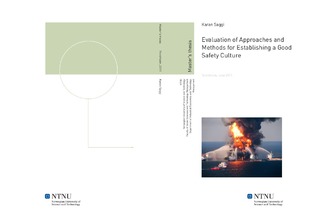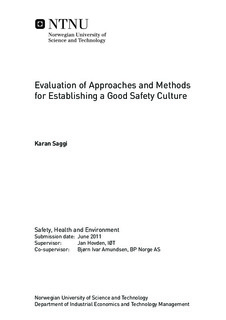| dc.description.abstract | The purpose of this thesis is to evaluate different approaches and methods used in the oil industry, based on theory, research and industrial experience. An evaluation of three oil companies safety culture approaches were therefore conducted; BP Norway, Conoco Phillips Norway and Wintershall Norway, in order to suggest an approach suited for establishing a good safety culture according to the Norwegian Framework Regulation §15. The Norwegian petroleum safety authority, Industri Energi (ABClub at BP Norway) and Samarbeid for Sikkerhet were also used to crosscheck the different organizations for similarities and differences to their safety culture approaches and methods, bringing in several aspects of the Norwegian oil industry.The evaluation was mainly based on Hale s (2000) eight elements, which were used as rationale for a good safety culture, according to the Norwegian Framework Regulation § 15. The evaluation was carried out by seven in-depth interviews from the six organizations, with employees in or close to management in order to target the views from the upper management.The results show that the oil companies have implemented many decent measures to establish a good safety culture, but still face some challenges to get the desired effect. The different safety culture approaches have managed to address many elements regarded as essential for establishing a good safety culture, however, to a various extent. For instance, the results confirm that the culture approach and the behavioural based safety (BBS) approach are better in some areas compared to others, each having their advantages. While the safety culture approach more easily create trust and a common starting point in the organization, the BBS approach is better with regards to involving their employees. Both approaches have, though, demonstrated that with several tools in place the creative mistrust is easily created, regardless of the path chosen. Finally, the results show that both approaches can give lasting changes to the safety culture, however, the culture approach has a better starting point as it provides a more extensive scope. Other research on safety culture has also confirmed this, and further highlights the importance of BBS elements, as it ultimately can pose an effect on the culture.Regarding the desired effect, the assignment also demonstrates that implementation of a safety culture approach alone is not enough to get a desired effect, as many additional success factors also creates challenges, e.g. that successful implementation needs strong commitment from management, as this will positively encourage the employees to follow. Moreover, the result also confirmed that only observing statistical aberrance on safety performance gave no guarantee of a safety culture change. The reason for this is because safety culture is by meaning hard to detect, and it is therefore important to work qualitatively, e.g. by management observation and communication with employees.To conclude, the thesis has shown that it is possible to establish a good safety culture using a safety culture approach with various methods, in order to create a lasting change. However, the fact that the companies see their approach as the most preferable creates challenges in the practical life, in relation to implementation of a common approach for the Norwegian oil industry. | nb_NO |

